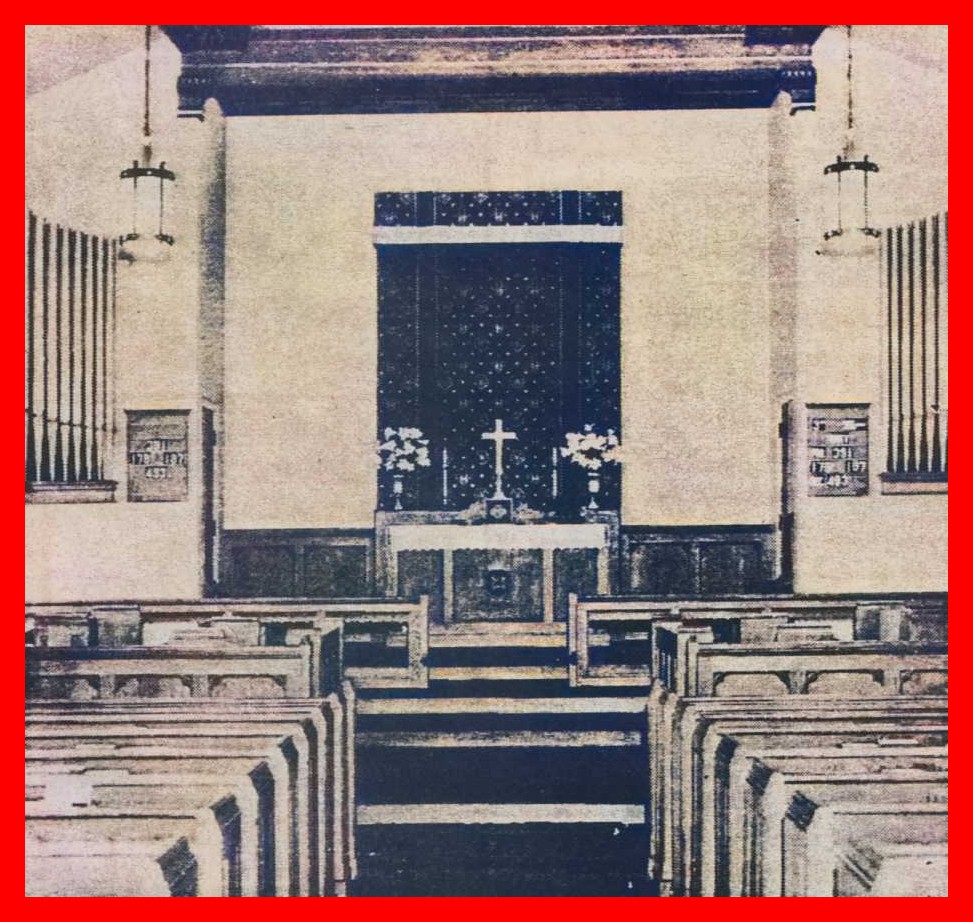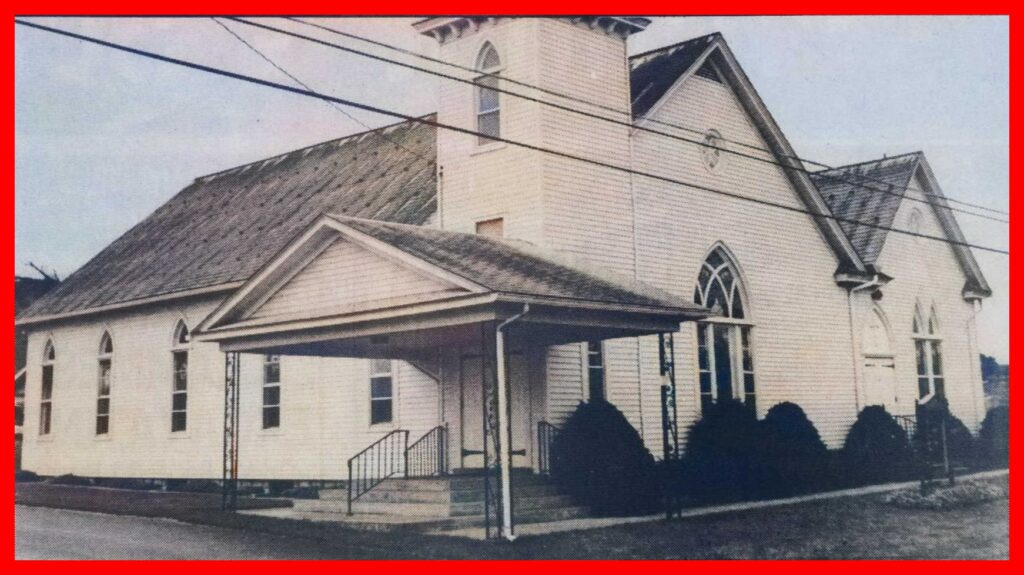A colorized newspaper photograph of the St John Lutheran Church, Leck Kill, Northumberland County, Pennsylvania. The church was built in 1914 and since then renovated several times.

A newspaper photograph taken around 1990 of the interior of the St. John Church, Leck Kill, Northumberland County, Pennsylvania.
The following story appeared in the Citizen-Standard, July 21, 1992. It was edited from an article in the St. John’s Church Centennial Celebration Souvenir Book, 1850-1950, by Rev. William H. Marburger, who served the congregation until 1952.
_________________________________________________
ST. JOHN’S CHURCH ORIGINATED AT LECK KILL in 1850
Lutherans Left Reformists in 1913
Compiled by Pastor William H. Marburger
The early history of our church is very obscure. To our knowledge, the only real justification of accepting the date of 1850 as the date of the organization of our congregation is the fact that pastors of the the congregation for a period of 60 or 70 years have reported to Synod that was the date of organization. It is assumed.
The congregation from the time of its organization until 1913 occupied the same building as St. John’s Reformed Congregation, Leck Kill. The first burial in the original cemetery was that of John Beisel, infant son of Mr. and Mrs. Daniel Beisel, who died February 21, 1853. On tradition is to the effect that the congregation was named St. John’s because of the name of this child.
The first definite record in the Record Books is in German. Translated it reads: “This new St. John Church was dedicated with a service to the Triune God on the 25th and 26th of December, 1853.” The first Lutheran Councilmen were Abraham Schneider, Peter Oxenrider, and Jacob J. Oxenrider. The pastor of the parish was the Rev. John G. August Bergner, a native of Germany, who emigrated to America in 1837.
The congregation was served for a short time in 1861 by the Rev. J. W. R. Hasskari but his pastorate was short because he refused to cooperate with the reformed congregations. In the years 1862 and 1863 the congregation was apparently served by the Rev. P. Anstadt, D. D., from Selinsgrove. When the Rev. J. C. Schmidt became pastor in 1864, the parish was reduced in size so that he only had to serve the churches of the present Urban, Herndon, and Line Mountain, and part of the Trevorton Parish. In those days this was considered a comparatively small parish. in 1869 Pastor Schmidt resigned as pastor of the parish but from 1870 to 1873 he served as the Pastor of St. John’s which apparently was not a part of any other parish during that period.
He was succeeded by the Rev. Henry Weicksel in January, 1874 and now began what was to prove the longest pastorate in the history of the congregation, a pastorate of 20 years, ending in January 1894 with the retirement of Pastor Weiksel, at the age of 77 years. Pastor Weiksel was born in Germany and emigrated to America in 1838. He began his ministry in the Pittsburgh Synod in 1848 and served parishes in that Synod until 1863. During his pastorate we find this entry in our record book: “The Evangelical Lutheran and reformed St. John Church in Upper Mahanoy Township, Northumberland County, Pennsylvania, was solemnly rededicated on the first day of january 1889, to the service of the Triune God.” The Pastor, the Rev. Henry Weiksel, and his son, the Rev. William Weiksel, were the Lutheran pastors present. The church had been extensively repaired and improved inside and outside, but the cost is not stated.
The next pastor to serve the congregation was the Rev. Solomon B. Stupp, who served from December 1895 to June 1897. He left no records to indicate what was done during his pastorate, but some of those who remember him testify he was a very excellent preacher.
The Rev. George J. Schaeffer became the pastor on June 1, 1897 and served until June 10, 1916. He had served the Richfield Rarish prior to entering upon his labors in the Line Mountain parish. After serving the parish for 19 years, he retired and continued to live on the territory of the parish until the time of his death on July 6, 1936. He, together with his wife, is buried in the Salem Cemetery. It was during his partorate that St. John Lutheran Church decided to leave the old Lutheran and Reformed Church and build its own church. The congregation numbered about 50 members at the time of the withdrawal. The congregation after withdrawing drew up and unanimously adopted its new constitution on August 9, 1913. reflecting the spirit of the time, it very carefully and rigidly defined the duties of the pastor, the church council, and all others. By its terms no pastor, except a Lutheran of the same Synod, was permitted to take part in any service nor even so much as to have any part in a burial service in the cemetery, The congregation immediately proceeded to the building of a new church and on May 16, 1914, the present church was dedicated.
From June 1916 to June 1917, the Rev. M. W. Krause, pastor of the Hegins or Pine Valley Parish, acted as the supply pastor. He performed the acts of the church and secured supply pastors to conduct the Sunday services.
The Rev. Phares G. Beer became the pastor in June 1917 and served until December 1920. By this time the Line Mountain Parish, as it is now constituted, had come into existence. During his pastorate the present and first parsonage of the parish was built at a cost of approximately $3,000. It was built on land donated by Mr. and Mrs. Albert Gessner.
The Rev. D. E. Fetherolf served the parish from March 26, 1921 to June 1936. Before being called to the Line Mountain Parish, he had served the Stone Valley parish. His pastorate was marked by a steady growth in the membership and by consistent improvement in the benevolence programs of the church.
The Rev. M. W. Krause was called from Ringtown Parish to succeed Pastor Feterolf and he served the parish from July 1936 until the time of his death, January 8, 1939. His death was hastened by an automobile accident several months previously.
Following the death of Pastor Krause, the parish turned to the city of Philadelphia for its next pastor and called the Rev. Samuel F. Staffer from St. Stephen’s Church. It was during his pastorate that the church was completely renovated with a view to having a more beautiful and better House of Worship.
Rev. Stauffer was succeeded by the Rev. Fred S. Blank on September 2, 1951 and it became his duty to see the church renovation through to lead in planning the rededication services, which were held on April 19, 1942, with the Rev.. H. H. Bechtold of Philadelphia delivering the sermon in the morning and former pastor Stauffer preaching in the evening.
On December 1, 1948, the present pastor [William H. Marburger] began his pastorate having been called from Trinity Lutheran Church, New Brighton.
______________________________________________
Photos appearing with this post were published with the Citizen-Standard article.
Corrections and additional information should be added as comments to this post.
